OFAC Cryptocurrency Sanctions and Compliance: What Crypto Businesses Must Do in 2025
OFAC Crypto Compliance Cost Estimator
Estimate Your OFAC Compliance Costs
Based on 2025 industry standards and OFAC enforcement data
Step 1: Enter Your Transaction Volume
Step 2: Select Compliance Tool
OFAC Cryptocurrency Sanctions Are Real - And They’re Getting Tighter
If you run a crypto exchange, wallet service, or even a DeFi platform that touches U.S. users, you’re already under OFAC’s microscope. The Office of Foreign Assets Control - part of the U.S. Treasury - doesn’t just target banks or shipping companies anymore. Since 2018, they’ve been adding cryptocurrency wallet addresses to their Specially Designated Nationals (SDN) List. By October 2025, that list included 1,247 crypto addresses tied to sanctioned entities like ransomware groups, Iranian cyber units, and Russian crypto exchanges. And the penalties aren’t theoretical. In September 2025, ShapeShift paid $750,000 just for letting users in Cuba and Iran trade over $12.5 million in crypto. No intent. No knowledge. Just liability.
How OFAC’s Rules Apply to Crypto - Even If You’re Not a Bank
OFAC doesn’t care if you’re a startup or a giant. If your business involves U.S. persons, U.S. financial systems, or even just one U.S. IP address, you’re covered. That means:
- Any crypto exchange serving U.S. customers must screen every transaction against the SDN List.
- Wallet providers must block access to any wallet tied to a sanctioned address - even if the user didn’t know it was blocked.
- DeFi protocols? Yes. Even if you’re just a smart contract with no central team, if U.S. users interact with it, OFAC expects you to have controls in place.
The 2021 Virtual Currency Compliance Guidance made this crystal clear: there’s no such thing as a crypto business outside OFAC’s reach. And in 2025, enforcement isn’t slowing down. The new Digital Asset Sanctions Task Force has 35 specialists focused solely on crypto violations. They’re not waiting for you to ask for help. They’re watching your transactions.
What You Have to Do: The Five Pillars of OFAC Compliance
OFAC doesn’t require perfection - but it does require a structured, documented program. Here’s what works:
- Management Commitment - Your board or executive team must sign off on compliance. Not a checkbox. Not an email. A formal policy with accountability.
- Risk Assessment - Update this every quarter. What chains do you support? Do you handle privacy coins like Monero? Do you serve users from high-risk jurisdictions? Document it.
- Internal Controls - This is where most fail. You need automated tools that screen every transaction in real time. Tools like Chainalysis, Elliptic, or TRM Labs connect to OFAC’s SDN List and flag matches. Don’t rely on manual checks. The SDN List adds 37 new crypto addresses every quarter.
- Testing and Auditing - Hire an independent third party to audit your system at least once a year. Internal teams miss things. Auditors find them before OFAC does.
- Training - Every employee who touches transactions needs training. ACAMS data shows compliance officers need 147 hours of specialized crypto sanctions training to get it right.
Skipping one of these? You’re already in violation.

Blocking Crypto Isn’t Like Blocking Bank Accounts - Here’s How It Works
When OFAC says “block,” they don’t mean freeze a bank account. They mean prevent any movement of digital assets tied to a sanctioned wallet. You have two options:
- Individual Wallet Blocking - Isolate each sanctioned wallet. If a user sends 0.5 ETH to a blocked address, the system rejects it. Simple, but messy at scale.
- Consolidated Blocked Wallet - Move all blocked assets into one designated wallet labeled “Blocked SDN Digital Currency.” OFAC allows this - as long as those assets can’t be moved, traded, or withdrawn. You don’t have to convert them to dollars. Just lock them.
Either way, you must report blocked assets to OFAC. The reporting rules depend on the value and type of asset. No reporting? That’s a second violation - on top of the original one.
The Tools You Need - And Which Ones Actually Work
You can’t do this manually. Blockchain analytics tools are non-negotiable. Here’s what top firms use:
| Tool | SDN List Updates | Privacy Coin Support | False Positive Rate | Implementation Cost | Documentation Rating |
|---|---|---|---|---|---|
| Chainalysis Reactor | Daily | Partial (Zcash, Monero limited) | 4.3% | $300K-$600K | 4.7/5 |
| Elliptic | Daily | Yes (with custom rules) | 6.1% | $250K-$500K | 4.3/5 |
| TRM Labs | Daily | Yes | 8.9% | $400K-$800K | 3.2/5 |
| Crystal Intelligence | Daily | Yes | 7.2% | $200K-$450K | 4.1/5 |
One Coinbase compliance officer said their false positives dropped from 18% to 4.3% after switching to Chainalysis - but it cost $450,000. Smaller firms often start with TRM or Crystal to save money. But if you process over $100 million daily, you need at least one full-time employee just managing alerts and tuning rules.
Where Most Companies Fail - And How to Avoid It
Here are the top three mistakes we see in 2025:
- Ignoring Geolocation - ShapeShift got fined because they didn’t block users based on IP addresses. If your platform lets users from Iran or North Korea sign up, you’re already violating sanctions. Use IP geolocation + device fingerprinting. Don’t trust self-reported locations.
- Not Screening DeFi - You can’t screen a liquidity pool if you don’t know who’s providing the funds. But you can limit exposure. Block known sanctioned addresses from interacting with your smart contracts. Use tools like Nansen or Arkham to monitor token flows.
- Thinking “We’re Too Small” - OFAC doesn’t care. Garantex was a small exchange. They processed $100 million in illicit crypto. They got designated - and so did six related companies. Your size doesn’t protect you.
And privacy coins? Monero and Zcash are the biggest headache. 68% of firms say they can’t fully screen them. OFAC’s October 2025 update says you still need “reasonable measures” - meaning you can’t ignore them. Block known mixing services. Flag high-risk transactions. Document your efforts. That’s your defense.

How the U.S. Compares to the Rest of the World
OFAC is the most aggressive. Here’s how others stack up:
- EU (6AMLD) - Uses a “reasonable measures” defense. If you tried to comply, you might avoid penalties.
- UK (OFSI) - Only 3 crypto enforcement actions since 2018. Much slower.
- Singapore (MAS) - 5 actions, mostly targeting exchanges with weak KYC.
- OFAC - 17 actions since 2018, $48.7 million in penalties. No “reasonable measures” defense. Strict liability. Period.
That means if you’re a U.S.-based company, or even just serve U.S. users, you have to meet OFAC’s bar - even if you’re also operating in Europe or Asia. You can’t pick and choose.
What’s Coming Next - And How to Prepare
OFAC isn’t done. Here’s what’s on the horizon:
- Network Sanctions - Garantex’s case showed OFAC going after not just the exchange, but its executives, successors, and supporting companies. Expect this to become standard.
- On-Chain Compliance - Ethereum is debating EIP-7594, which would let smart contracts block transactions automatically. It’s controversial, but the direction is clear: compliance is moving into the protocol layer.
- Budget Increases - The U.S. Treasury requested $28 million for crypto sanctions enforcement in 2026 - up 40% from last year.
- Wallet Screening - Only 17 out of 124 crypto wallets have built-in sanction screening. That’s changing fast. Expect MetaMask, Trust Wallet, and others to add it by 2026.
For now, your best move is to build a program that’s scalable, documented, and auditable. Don’t wait for OFAC to find you. Find yourself first.
Getting Started: Your 6-Month Compliance Roadmap
Here’s a realistic timeline if you’re starting from scratch:
- Month 1-2 - Do your risk assessment. List all chains, coins, jurisdictions, and user types. Identify your biggest gaps.
- Month 3-4 - Pick and implement a blockchain analytics tool. Start with a pilot on one chain (like Ethereum or Bitcoin).
- Month 5 - Integrate the tool with your transaction system. Test blocking, reporting, and alert workflows.
- Month 6 - Train your team. Run an internal audit. Document everything. Get your board to sign off.
Most firms take 22 to 36 weeks to fully implement. Don’t rush. But don’t delay. The penalties are too high.
Does OFAC only target exchanges?
No. OFAC applies to any entity that handles digital assets and involves U.S. persons or the U.S. financial system. That includes wallet providers, DeFi platforms, crypto ATMs, payment processors, and even individuals who knowingly transact with sanctioned addresses.
What happens if I accidentally transact with a sanctioned wallet?
You’re still liable. OFAC operates under strict liability - meaning intent doesn’t matter. If your system didn’t block the transaction, you violated the rules. The key is having a documented compliance program. That doesn’t excuse the violation, but it can reduce penalties.
Can I still use privacy coins like Monero?
Yes - but you must take “reasonable measures” to prevent transactions with sanctioned addresses. That means blocking known mixing services, flagging high-risk transfers, and documenting your screening efforts. You can’t ignore them, but you don’t have to fully trace them - yet.
Do I need to convert blocked crypto to USD?
No. OFAC explicitly says you don’t have to convert blocked digital assets into fiat. You can keep them in a locked wallet labeled “Blocked SDN Digital Currency.” Just make sure they can’t be moved, traded, or withdrawn.
How often does OFAC update its crypto sanctions list?
OFAC updates the SDN List daily. In Q2 2025 alone, they added 37 new cryptocurrency addresses. Your compliance tool must sync with OFAC’s API in real time. Manual checks won’t cut it.
Is there a free way to screen crypto addresses?
OFAC provides a public SDN List, but it’s not designed for automation. You can download it, but you’ll need to build your own system to screen blockchain transactions. Most small firms use free trials from Chainalysis or Elliptic to test before paying. There’s no true free, scalable solution.
What if I’m based outside the U.S.?
If you serve U.S. users, process transactions through U.S. banks, or have U.S. employees, OFAC still applies. Many non-U.S. exchanges have blocked U.S. users entirely to avoid compliance risk. Others use geo-blocking and third-party compliance tools to stay legal.
Eli PINEDA
November 1, 2025 AT 09:36Genevieve Rachal
November 2, 2025 AT 16:50And don’t even get me started on how Chainalysis false positives wreck your support team. I had one client lose 14 customers in a week because their withdrawals got ‘flagged’ for being ‘associated with a sanctioned address’-turns out it was a legit user who once bought ETH from a mixer in 2019. That’s not compliance. That’s digital witch hunting.
Debby Ananda
November 4, 2025 AT 05:38Can we please admit this is just US imperialism wrapped in blockchain jargon? 🤦♀️
They’re not protecting national security-they’re controlling money flow so only Big Tech and Wall Street get to play. Monero isn’t the problem. Power is.
Vicki Fletcher
November 5, 2025 AT 05:49Nadiya Edwards
November 6, 2025 AT 01:21Malinda Black
November 7, 2025 AT 04:32ISAH Isah
November 7, 2025 AT 22:33Chris Strife
November 9, 2025 AT 10:30Mehak Sharma
November 9, 2025 AT 19:36bob marley
November 10, 2025 AT 16:48Jeremy Jaramillo
November 11, 2025 AT 09:29Sammy Krigs
November 12, 2025 AT 15:11Wesley Grimm
November 13, 2025 AT 14:37Eliane Karp Toledo
November 14, 2025 AT 21:23Jason Coe
November 16, 2025 AT 18:32Brett Benton
November 17, 2025 AT 22:22David Roberts
November 18, 2025 AT 11:30Monty Tran
November 19, 2025 AT 18:29